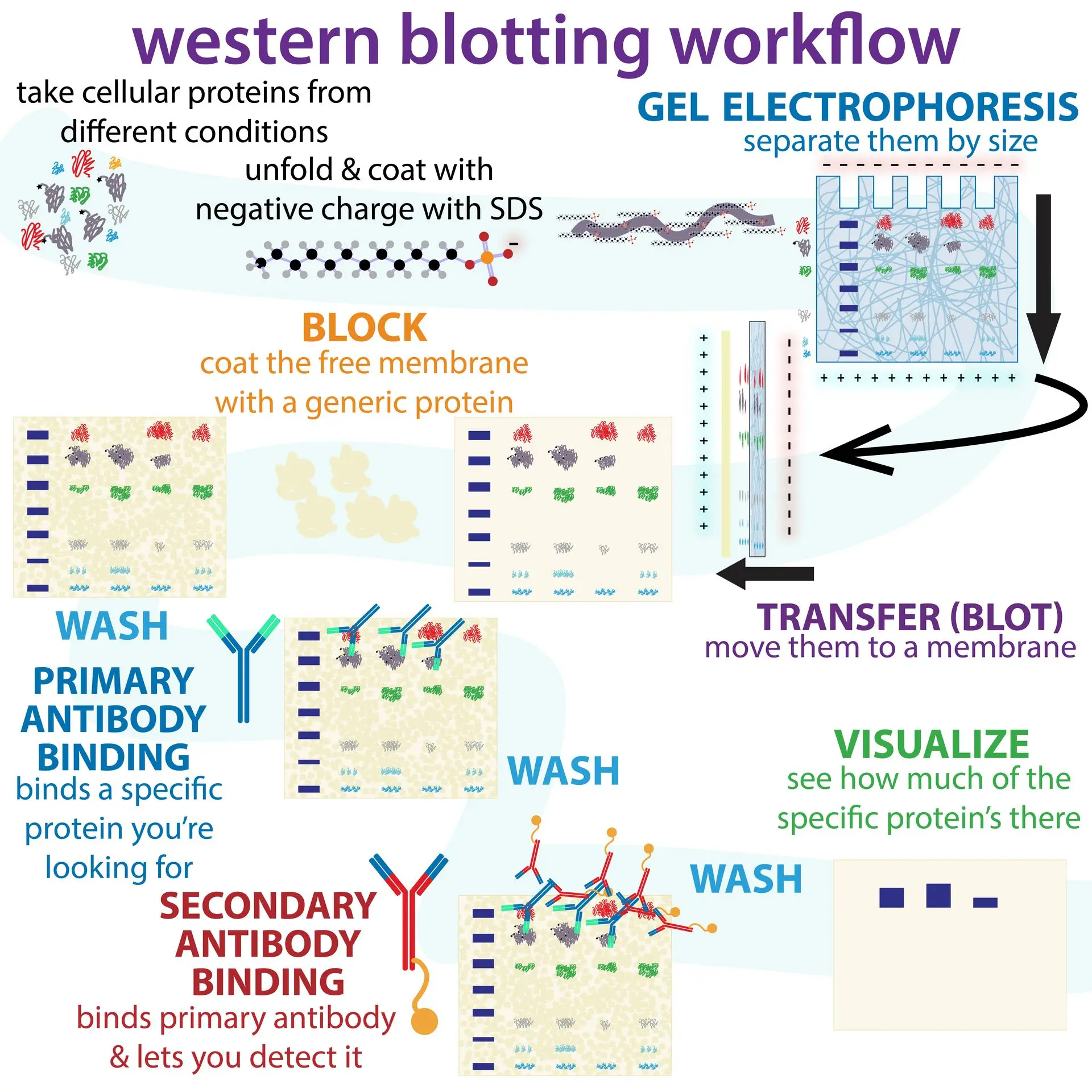🧪 Western Blot: A Cornerstone in Protein Detection
🔬 Introduction
Western blotting is a foundational technique in molecular biology used to detect, identify, and quantify specific proteins in a complex biological sample. This method has revolutionized how scientists validate gene expression at the protein level, diagnose diseases, and study cellular responses in both research and clinical settings.
Initially developed in the late 1970s, the technique has since evolved to incorporate highly sensitive detection systems and automation. Despite the rise of newer technologies, Western blot remains irreplaceable due to its reliability, specificity, and affordability.

🧭 What Is Western Blotting?
Western blotting, also called immunoblotting, is a three-step analytical process:
- Protein Separation – Proteins are separated by size using SDS-PAGE (sodium dodecyl sulfate–polyacrylamide gel electrophoresis).
- Transfer to Membrane – Separated proteins are transferred from the gel to a stable membrane (usually PVDF or nitrocellulose).
- Antibody-Based Detection – The membrane is probed with antibodies specific to the target protein.
The final result is a blot where the presence of a specific protein is visualized as bands, often using chemiluminescent, fluorescent, or colorimetric signals.
🔄 Step-by-Step Workflow
1️⃣ Sample Preparation
Cells or tissues are lysed to extract the total protein content. Protease and phosphatase inhibitors are often added to preserve protein integrity.
2️⃣ SDS-PAGE Electrophoresis
Proteins are denatured and loaded into a polyacrylamide gel. The gel applies an electric current to separate proteins based on molecular weight.
3️⃣ Membrane Transfer
The proteins are moved from the gel to a membrane via electrical current in a transfer buffer. This step immobilizes the proteins for antibody probing.
4️⃣ Blocking
Non-specific sites on the membrane are blocked using proteins like BSA or milk to reduce background noise.
5️⃣ Primary Antibody Incubation
An antibody specific to the protein of interest binds to its target.
6️⃣ Secondary Antibody Incubation
A labeled secondary antibody binds to the primary antibody. It carries a tag such as horseradish peroxidase (HRP) or a fluorophore.
7️⃣ Detection
A chemiluminescent or fluorescent substrate reveals the band corresponding to the protein.
📷 [Image placeholder: Full workflow diagram]
🎯 Suggested icon: step-by-step lab iconography for intuitive navigation
🧬 Applications of Western Blotting
Western blotting is used across multiple scientific and medical disciplines:
- 🔍 Molecular Biology: Validate gene expression at the protein level.
- 💉 Immunology: Study antigen-antibody interactions and immune responses.
- 🧪 Biotechnology: Monitor protein production in engineered organisms.
- 🧬 Medical Diagnostics: Detect specific proteins associated with diseases (e.g., HIV, Lyme disease, cancer biomarkers).
- 🧠 Neuroscience: Investigate protein misfolding and aggregation in diseases like Alzheimer’s.
- 🧫 Pharmaceuticals: Quality control of therapeutic proteins and monoclonal antibodies.
🧠 Troubleshooting & Optimization Tips
Western blotting is powerful but sensitive to technique. Here are key points to ensure success:
- ✅ Use fresh, well-preserved samples with appropriate controls.
- ✅ Validate both primary and secondary antibodies for specificity.
- ✅ Optimize blocking and washing conditions to reduce background noise.
- ✅ Include loading controls (e.g., GAPDH, β-actin) for normalization.
- ✅ Use low-background substrates for better clarity in detection.
💡 Icon: Lightbulb for lab tips, question mark for FAQs
🌐 Western Blot in the Era of Modern Biology
Although newer technologies like mass spectrometry and protein arrays are emerging, Western blotting remains an indispensable tool. In the age of personalized medicine, it is used for:
- Verifying patient-specific biomarkers
- Confirming CRISPR/Cas9 gene edits at the protein level
- Supporting preclinical studies and biomanufacturing validation
📚 Related Technologies
For students and professionals wanting to broaden their understanding, here are technologies often used alongside Western blotting:
| Technology | Purpose | Combined Use |
|---|---|---|
| ELISA | Quantitative protein detection | Use ELISA to measure, Western to confirm |
| qPCR | Gene expression at mRNA level | Cross-validate with protein expression |
| Immunofluorescence | Protein localization in cells | Confirm target protein presence |
| Mass Spectrometry | High-throughput protein identification | Use Western blot for validation |
📘 Icon: Open book | PDF download links optional
🧰 Resources and Protocols
- Western Blotting Protocol (PDF)
- Antibody Selection Guide
- Sample Preparation Checklist
- Loading Control Reference Table
📎 Include downloadable links or product CTAs if integrating with e-commerce
🎓 Why Students Should Learn Western Blotting
Western blotting is a core skill in modern biology programs. Students learn:
- Protein handling and extraction
- Experimental design and antibody validation
- Scientific rigor through replication and troubleshooting
It’s frequently taught in university lab courses, used in undergraduate research, and essential for graduate-level molecular biology.
“A single band on a Western blot may represent months of discovery.”